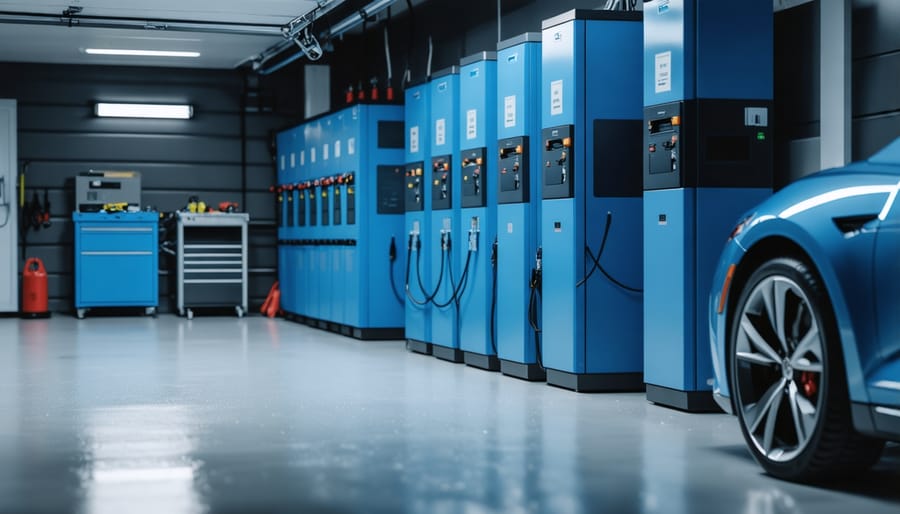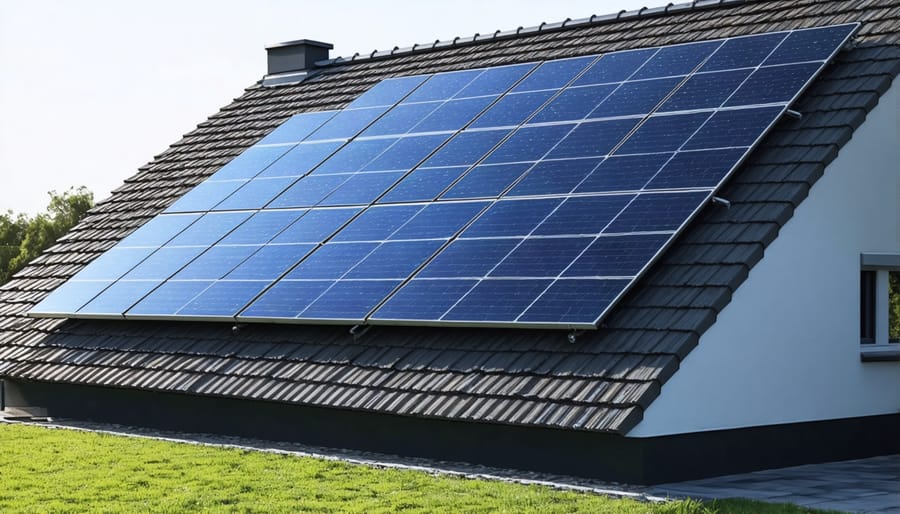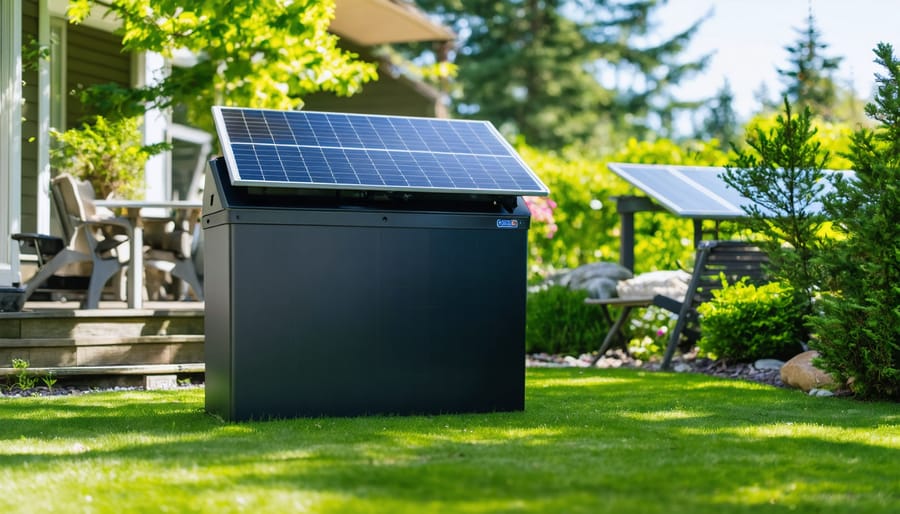Solar panel batteries typically last 10-15 years, but smart maintenance and proper system design can extend their lifespan significantly. In British Columbia’s diverse climate, from coastal humidity to interior temperature swings, battery performance and longevity depend heavily on installation location and usage patterns. Modern lithium-ion batteries outperform traditional lead-acid options, often delivering 5-7 more years of reliable service while requiring minimal maintenance.
For BC homeowners investing in solar energy storage, understanding battery lifespan isn’t just about years—it’s about maximizing return on investment and ensuring consistent power availability during our region’s frequent winter storms and occasional outages. Current technological advances have dramatically improved battery efficiency and durability, making solar storage more practical and cost-effective than ever before.
Whether you’re considering a new installation or maintaining existing equipment, proper battery management can mean the difference between replacement at 8 years or optimal performance beyond 15 years. Let’s explore how to maximize your solar battery’s lifespan in BC’s unique environment.
Understanding Solar Battery Types and Their Lifespans
Lithium-Ion Batteries
Lithium-ion batteries have become the preferred choice for solar energy storage in British Columbia homes, offering an impressive lifespan of 10-15 years under optimal conditions. These modern batteries typically retain 80% of their original capacity after a decade of regular use, making them a reliable long-term investment for your solar system.
What sets lithium-ion batteries apart is their high energy density and minimal maintenance requirements. Unlike older battery technologies, they don’t need regular water top-ups or extensive care routines. They also perform exceptionally well in BC’s varied climate, maintaining consistent performance in both our cool winters and warm summers.
Many local homeowners appreciate that lithium-ion batteries can handle daily charging cycles without significant degradation. A real-world example comes from the Thompson-Okanagan region, where solar installations with lithium-ion batteries have shown only a 2-3% capacity loss per year, even with regular use.
While the initial cost is higher than other battery types, the longer lifespan and superior performance make lithium-ion batteries a cost-effective choice for most BC households. They’re also more compact, requiring less space in your home while delivering reliable power storage for your solar system.
Lead-Acid Batteries
Lead-acid batteries have been a reliable workhorse in solar energy systems for decades, particularly popular among BC homeowners due to their affordability and proven track record. These traditional batteries typically last between 5-10 years when properly maintained, though their lifespan can vary significantly based on usage patterns and environmental conditions.
In our coastal climate, lead-acid batteries generally perform well, but they require regular maintenance to achieve their full potential. Most systems use either flooded lead-acid batteries, which need periodic water top-ups and terminal cleaning, or sealed lead-acid batteries, which are maintenance-free but slightly more expensive.
A key advantage of lead-acid batteries is their ability to withstand our cold winter temperatures, though extreme conditions can reduce their capacity. To maximize their lifespan, it’s crucial to keep them in a temperature-controlled environment and avoid depleting them below 50% capacity.
While they may not match the longevity of newer technologies, lead-acid batteries remain a cost-effective choice for many BC households, especially those starting their solar journey on a budget. Regular maintenance and proper charging practices can help these batteries serve reliably for years.
Factors Affecting Solar Battery Life
Temperature and Climate Impact
British Columbia’s diverse climate zones present unique challenges for solar battery performance. In coastal regions like Vancouver and Victoria, high humidity levels and mild temperatures generally support stable battery operation. However, interior regions experience more extreme temperature variations, which can significantly affect battery lifespan.
Cold temperatures below 0°C can reduce a battery’s charging capacity and discharge rate, similar to how the impact of partial shading affects solar panel efficiency. During winter months, batteries may require additional maintenance and monitoring to maintain optimal performance. Conversely, excessive heat in BC’s interior summer months can accelerate chemical reactions within batteries, potentially shortening their overall lifespan.
To maximize battery longevity in BC’s climate, consider installing your battery system in a temperature-controlled environment, ideally between 10°C and 25°C. Many BC homeowners choose to house their batteries in insulated garages or dedicated battery rooms. This approach has proven successful for numerous local installations, with some systems maintaining over 80% of their original capacity even after 8-10 years of operation.

Usage Patterns and Depth of Discharge
Your battery’s usage patterns significantly impact its lifespan. Think of your solar battery like a marathon runner – the more demanding the race, the more rest and care needed. Regularly draining your battery to very low levels (deep discharge) can reduce its lifespan considerably. For optimal longevity, try to maintain your battery’s charge between 20% and 80% capacity.
Many BC homeowners find success by adjusting their energy consumption patterns to match peak solar production hours. For example, running major appliances during sunny afternoons rather than evenings can help maintain healthier battery levels. Some local families report extending their battery life by up to 25% simply by implementing smart usage habits.
The depth of discharge (DoD) you regularly use affects battery longevity. While most modern batteries can handle deep discharges, limiting them to 50% DoD can significantly extend their lifespan. Consider programming your system to maintain these optimal levels automatically, especially during BC’s shorter winter days.
Maintenance and Care
Regular maintenance is crucial for maximizing your solar battery’s lifespan. Keep your batteries in a clean, dry environment with proper ventilation, ideally between 20-25°C. In BC’s varied climate, protect your batteries from extreme temperatures by installing them in an insulated space.
Check battery connections monthly for corrosion and ensure they’re tight. Monitor the electrolyte levels in flooded lead-acid batteries every three months, topping up with distilled water when needed. For all battery types, maintain proper charge levels and avoid frequent deep discharging.
Track your battery’s performance using monitoring systems, which can alert you to potential issues before they become serious problems. Clean solar panels regularly, especially during pollen season and after winter storms, to ensure optimal charging. Consider scheduling professional maintenance checks annually, particularly before winter, to ensure your system performs efficiently during BC’s darker months.
Remember, consistent care significantly extends battery life and protects your investment in sustainable energy.


Maximizing Your Solar Battery Investment
Sizing Your System Correctly
Choosing the right battery capacity is crucial for optimal solar system performance and longevity. In British Columbia, where seasonal variations can significantly impact solar generation, proper sizing becomes even more critical.
Start by calculating your daily energy consumption in kilowatt-hours (kWh). Consider both your current needs and potential future increases in energy usage. A typical BC household uses between 22-30 kWh per day, but your actual usage may vary.
For off-grid systems, we recommend sizing your battery bank to store 2-3 days’ worth of energy to account for cloudy weather patterns common in coastal BC regions. Grid-tied systems typically need smaller batteries, focusing instead on evening usage and emergency backup.
Remember to factor in these key considerations:
– Depth of discharge (DoD) limitations
– Temperature fluctuations in your area
– Seasonal variations in solar production
– Future expansion plans
– Battery efficiency losses
For example, if your daily usage is 25 kWh and you want two days of autonomy with a 50% DoD, you’ll need a battery system rated for at least 100 kWh. Working with a local solar professional can help fine-tune these calculations for your specific situation.
Professional Installation and Monitoring
Professional installation of your solar battery system is crucial for maximizing its lifespan and ensuring optimal solar panel efficiency. In British Columbia, where weather conditions can be challenging, proper installation becomes even more critical. Local certified installers understand our unique climate and can position your system to withstand coastal humidity and seasonal temperature fluctuations.
Regular monitoring is equally important for battery longevity. Modern solar battery systems come equipped with smart monitoring technologies that track performance metrics, charging cycles, and temperature variations. This data helps identify potential issues before they become serious problems.
Many BC homeowners have found success with professional monitoring services that provide real-time system oversight. For example, the Thompson family in Victoria extended their battery’s lifespan by two years through early detection of charging inefficiencies. Their monitoring system alerted them to unusual discharge patterns, allowing for quick adjustments to their usage habits.
We recommend scheduling professional inspections at least twice yearly, particularly before winter and summer seasons. These check-ups typically include:
– Battery connection verification
– Charge controller settings optimization
– Temperature regulation system testing
– Performance data analysis
– Corrosion inspection and prevention
By investing in professional installation and monitoring, you’re not just protecting your battery – you’re ensuring the long-term success of your solar investment.
When to Replace Your Solar Batteries
Knowing when to replace your solar batteries is crucial for maintaining an efficient energy system. Here in British Columbia, where many homeowners rely on solar storage during our cloudy winters, recognizing the signs of battery degradation can help you avoid unexpected power disruptions.
Watch for these key indicators that suggest it’s time for a replacement:
– Your batteries hold less charge than before, requiring more frequent recharging
– The system takes longer to charge fully
– Visible swelling or damage to the battery casing
– Decreased power output during peak usage
– More frequent system warnings or error messages
– Batteries are approaching or have exceeded their warranty period
Most solar batteries in BC installations last between 5-15 years, depending on usage patterns and maintenance. Consider replacement when your batteries reach 60-70% of their original capacity, as efficiency typically declines more rapidly after this point.
Local environmental factors like our cold winters and seasonal temperature fluctuations can impact battery performance. If you notice your system struggling during these challenging conditions, it might be time for an upgrade.
Remember, timing your replacement strategically can help avoid emergency situations. Many BC homeowners choose to replace their batteries during spring or fall when energy demands are lower. This allows for a smooth transition and ensures your system is ready for the more demanding summer and winter months.
Before making the decision, consult with a local solar expert who understands our unique climate conditions and can recommend the best replacement options for your specific setup.
Solar panel batteries are a vital investment in your sustainable energy future, typically lasting between 5 to 15 years depending on the type and maintenance. By understanding the factors that affect battery life and implementing proper care strategies, you can maximize your system’s performance and longevity. Regular maintenance, protecting batteries from extreme temperatures, and monitoring charging cycles are key to extending their lifespan. Here in British Columbia, many homeowners have successfully extended their battery life beyond initial expectations through proper care and timely upgrades. Take the first step today by assessing your current system or planning your new installation with these guidelines in mind. Remember, a well-maintained solar battery system not only provides reliable power but also contributes to a greener, more sustainable future for our BC communities.

